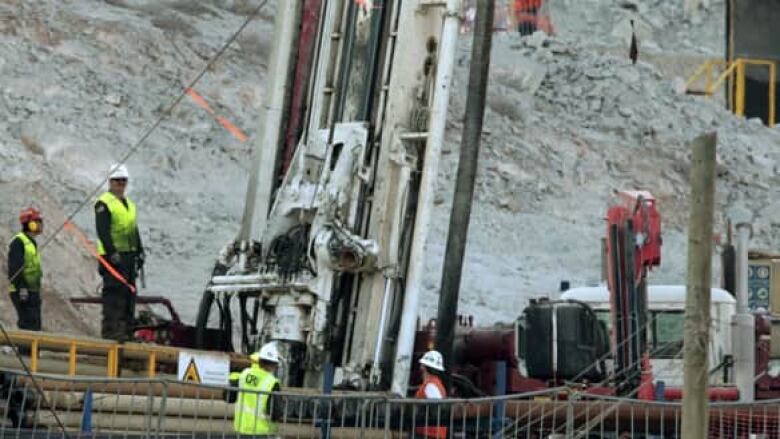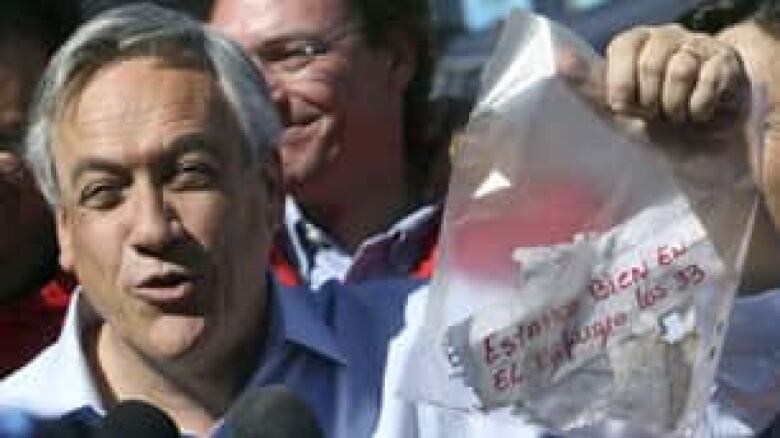Tricky path to surface for 33 Chilean miners

After more than two months trapped underground, 33 miners in Chile have entered thefinal chapter of their ordeal. The minerseclipsed all records for the longest time anyone has livedtrapped underground.
The first rescue began in the late evening of Tuesday, Oct. 12, when 31-year-old Florencio Avalos was raised through a rescue shaft.
The other miners were thenpulled up, one by one,630 metres from the cavern where they became trapped on Aug. 5 whenpart of the main tunnel collapsed in the copper and gold mine near Copiapo in northern Chile.
Seventeen days later, the country rejoiced when a narrow bore hole reached a rescue station deep within the mine and the workers sent back a note saying they were all alive.
Then began the hard work of planning a rescue operation on a scale never before attempted. Engineers, psychologists, doctors, rig workers, politicians and rescuers ranthrough simulations of the effort to make sure it went as smoothly as possible and to try to anticipatethe risks.
Rescue shaft
A 30-centimetre-wide hole was bored all the way down last month, reaching the trapped miners on Sept. 17. It then had to be widened further to create room for them to be lifted up while strapped inside a metal capsule.
The shaft to the workers was the so-called Plan B hole, drilled by a Schramm T-130 drill fromGeotec Boyles, a Latin American affiliate of Kansas City-based Layne Christensen Co.

The first decision engineers had to make about the widened tunnel was whether to line it with a protective steel casing.
The steel tubes could guard against a possible fracture in the rock that could trap a miner inside as he was being hoisted up, but they wouldn't come without risk. The rescue shaft is slightly curved at its top, and inserting the tubes could cause cracks and possibly jam the escape route.
Officials decided to encase only the top section of the tunnel. Sixteen sections of 1.27-centimetre-thick steel pipe were installed into the first 96 metres of the hole, which curves like a waterfall at first before becoming nearly vertical for most of its descent.
Escape capsule
The 420-kilogram escape capsule, dubbed the Phoenix, took as little as 15 minutes to make a trip to the surface.

The steel craft, designed by the Chilean navy, has rubber wheels to negotiate bends in the rescue shaft, as well as oxygen, wired communications equipment, an escape hatch, and food and water.
The capsule is standing-room-only, with about 1.9 metres of vertical space and a diameter of 54 centimetres a tight squeeze for a broad-shouldered miner. It was winched up by a crane, and anyone riding in it wore a helmet and gloves.
Doctors on the surface had been leading the miners through physical exercises, including 20 minutes a day of aerobic activity, in preparation for the trip up. Each miner was supposed to fast for eight hours before riding the capsule.
Who goes first
Before anyonewaspulled up, medics from the Chilean navy and rescuers from mine operator Compania Minera San Esteban Primera were sent down to assess the miners and organize their ascent. Those rescuers had authority to change alist of who was to be pulled out when.
Imaging the rescue
Chile's two leading newspapers, El Mercurio and La Tercera, have published helpful graphics explaining the mine accident, the effortto find the miners and the rescue plan.Even if you do not read Spanish they areworth a look.
These are the links to La Tercera's graphics of:
- The search effort.
- The families'Camp Hopeat the mine head.
- The rescue plan.
(An adaptation in English of one of La Tercera's graphics of the accident ishere.)
This is alink to El Mercurio's graphics.
Chilean navy Cmdr. Renato Navarro said the thinking was to have a physically and psychologically strong miner come up first, in case of a rescue capsule jam and so that he couldtell his waiting colleagues how best to manage the ascent.
Next were men with medical or other problems, followed by those deemed to have the mental fortitude for the strain of being the last ones left below while their co-workers disappeared up into the light of day.
Surface procedure
A variety of medical concerns needed to be addressed forthe voyage to the surface and upon arrival. The miners did leg-strengthening drills to build up enough stamina to be able to stand still for up to an hour. They were equipped with $450 pairs of sunglasses to protect their eyes from the sun once they arrived. After more than two months of seeing no more than dim artificial light, their retinas could have been badly damaged by sudden exposure to the sun's rays.
Upon reaching the surface, each miner was to undergo a 45-minute medical and psychological exam. Concerns included skin or fungal infections they might have contracted in the moist climate of the mine, and that their immune systems could have lost resistance to common germs. They had been sent flu shots to administer below ground to fortify them against possible infection.
Life goes on
After that, it's back to day-to-day life with all the travails it will entail.
Miner Esteban Rojas, who has been with his wife for 25 years but never had traditional church nuptials, has promised her a big Catholic wedding ceremony to cement their marriage.
Mario Gomez,at 63the oldest of the trapped miners, planned to retire in November and will probably move up his departure date.
Other miners will have psychological hurdles to overcome. Victor Segovia, in a letter sent up to the surface to his family, said he has frequent nightmares that he's trapped in an oven. Carlos Mamani, the only non-Chilean in the group (he's from Bolivia), has been so traumatized that he will never again work in a mine, his father-in-law says.
For Chile, therescue is an inspiration in a country devastated by an earthquake in February that killed several hundred people.
And for the world, from all parts of which came assistance and goodwill, the mining disaster has shown the ennobling spirit that unites people in the face of adversity.












_(720p).jpg)


 OFFICIAL HD MUSIC VIDEO.jpg)
.jpg)



























































































